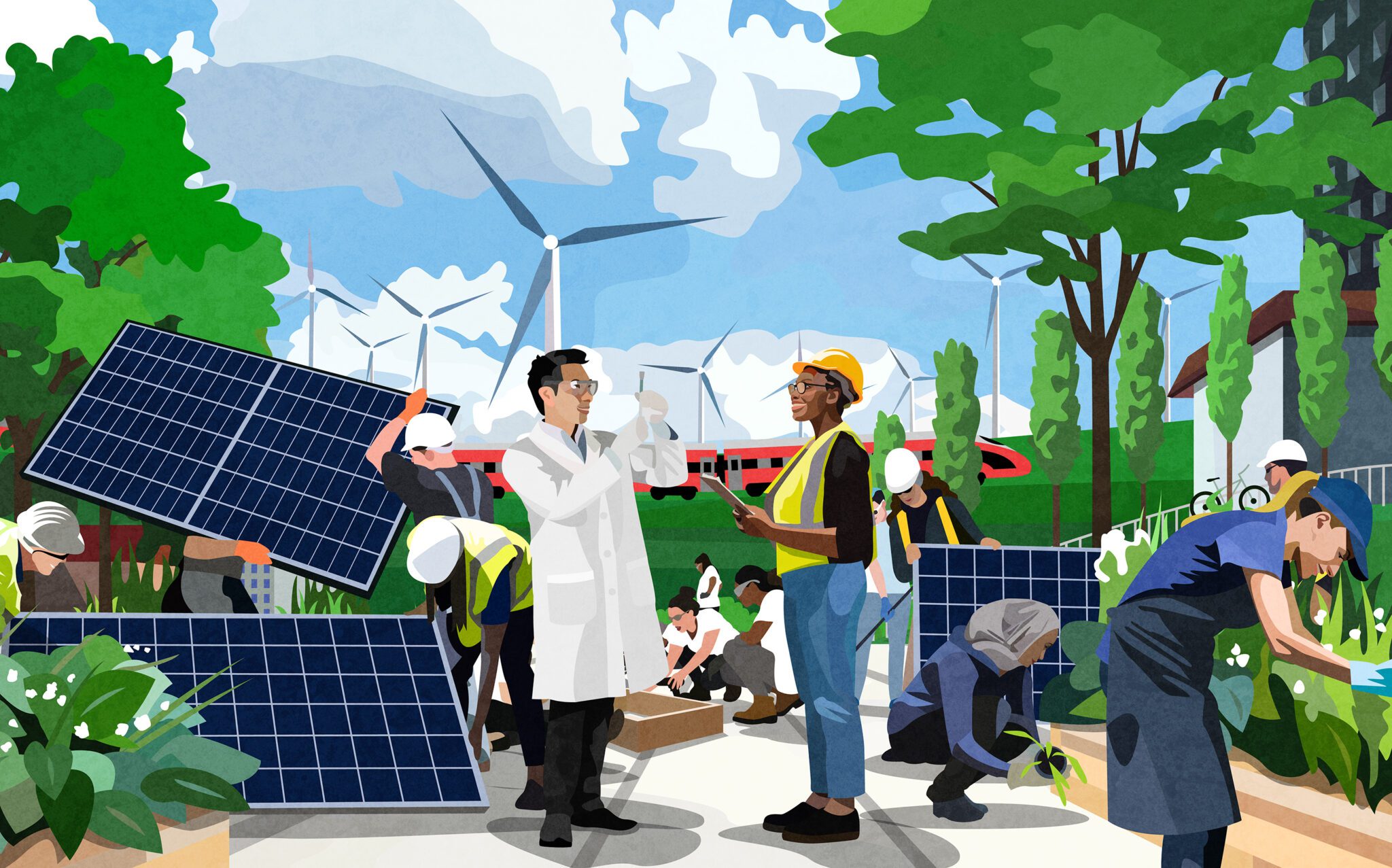On June 18, 2024, Senators voted to pass the Sustainable Jobs Act, or Bill C-50. With that, the bill officially became law after a long journey through Parliament. This is a victory worth celebrating!
Thanks to this bill, workers and communities impacted by the energy transition will be given the tools they need to succeed in the green economy. Countries that are leading the transition to a green economy have had similar legislation for years.
It took time to get the legislation to this important milestone. Despite being a good and necessary policy, Bill C-50 faced fierce opposition from the oil and gas industry and the politicians who defend big polluters.
Now that the dust has settled and the legislation has been adopted, let’s look back at what the Sustainable Jobs Act will achieve for Canadians.
Bill C-50 is a necessary tool to set Canadian workers up for success in a low-carbon economy
Countries around the world are choosing to ditch fossil fuels, like oil, gas and coal, to use renewable energy and increase the energy efficiency of homes, cars and factories. Doing this is necessary to keep global warming in check and avoid the worst of the climate crisis.
This shift is a major opportunity for Canada. We can become a leader in clean energy supply and manufacture the products the world needs to live more sustainably. We are doing some of that today, but many parts of Canada’s economy and workforce still depend on revenue from oil and gas and other polluting industries.
While only a small percentage of Canada’s workforce is employed by the fossil fuel industry, each of these jobs puts food on a family’s table. Fossil fuel workers are also far from the only ones impacted. From those who manufacture internal combustion engine cars and their parts to those who work in the service industry that feeds, houses and equips all these workers, many jobs are tied to today’s polluting industries.
Failure to prepare could leave workers and their families to fend for themselves.
That’s not acceptable. Mass layoffs, difficult transition periods, and forced relocations are entirely avoidable. But we need to plan for that, and bring the workers and communities who will be impacted to the table as part of that planning. Then, we need to map out what jobs will be lost, where the new employment opportunities are, and develop a package of skills training, income support and other services to support the transition.
That is what the Sustainable Jobs Act sets out to do. As we explain below, it brings impacted parties to the table, proposes ways to address their needs, and commits the government to regularly updating its plans as the reality on the ground evolves.
What is a Sustainable Job?
The text that Members of Parliament agreed on defines a sustainable job as:
“Any job that is compatible with Canada’s pathway to achieving a net-zero-emissions and climate-resilient future and that reflects the concept of decent work, namely work — including a job in which the worker is represented by a trade union that has entered into a collective agreement — that can support the worker and their family over time and that includes elements such as fair income, job security, social protection and social dialogue.”
It’s a mouthful! In short, it means that the jobs the government will help create, through investments and policies, have to be good jobs where workers are well-paid and safe in sectors that are aligned with Canada’s climate plans.
This could include construction workers who are building energy efficient buildings, tradespeople installing, building, and maintaining renewable energy projects like wind and solar, or tech workers designing and engineering sustainable technologies to reduce our environmental footprint and improve our lives.
Bill C-50 ensures a more certain, consistent and reliable approach to energy transition policies
The Sustainable Jobs Act is a law that mandates future government action. Unlike criminal laws that tell you and me what to do (and not do!), this one doesn’t require us to change anything. Instead, it legally commits the federal government to take a series of actions, like having specialized government agencies to advance sustainable jobs or consulting with impacted parties at regular intervals.
Can’t the government just do that without being legally forced to?
Sure it can, and it already has in small ways. However, having this as a law gives impacted workers certainty that even if the Minister in charge of the issue or the entire government changes, it will still be obligated to provide some support to those impacted by the transition.
The law also lays out principles so that all government agencies involved are working towards the same goals. Some of the principles include:
- Engaging stakeholders and partners to build strong social consensus in the shift to a net-zero economy
- Supporting the creation of good-paying, high-quality jobs
- Recognizing local and regional needs
- Being inclusive and address barriers to employment with an emphasis on encouraging the creation of employment opportunities for groups underrepresented in the labour market
- Advancing the well-being of workers and communities, as well as the achievement of Canada’s climate goals in line with the Paris Agreement
Currently, Energy and Natural Resources Minister Jonathan Wilkinson will be responsible for the sustainable jobs file.
There will be two new bodies to help the government get it right
A new Sustainable Jobs Secretariat, staffed by civil servants, will coordinate the delivery of policies and programs. Programs can range from skills training, connecting employers and workers, providing income support if there is a temporary gap in a worker’s revenue while they transition, or offering the option of early retirement for workers who are close to retiring and don’t want to find a new role. Other policies could encourage clean energy projects that hire apprentices or unionized workers and provide direct support to Indigenous nations for ownership of projects.
The Secretariat will be a coordinating body between the various parts of the government involved in delivering the programs above – we counted 14 different departments and agencies that could be implicated!
This will also allow the Secretariat to be a one-stop shop for impacted groups – whether it’s a local union president who wants to know what she can offer her members in terms of skills training, or a college that needs data on what the jobs of the future will look like to change its course offering, the Secretariat should be able to answer that.
Bill C-50 also creates a new Sustainable Jobs Partnership Council, made up of people outside the government who represent industry, workers, Indigenous peoples and energy transition experts. The Council will advise the Minister on policies and programs needed to promote sustainable jobs and address the energy transition’s impacts on jobs and community well-being. The 13 Council members will also engage with a broad range of stakeholders and use that input to develop recommendations.
The Partnership Council will issue annual reports with its advice, which the Minister will need to publicly respond to and explain how it’s implementing that advice.
Starting in 2025, the government will propose action plans every five years and progress reports every 2.5 years
The Sustainable Jobs Act is particularly good at ensuring the government will be accountable and transparent.
Every five years, starting in 2025, the Minister must prepare a plan that outlines how the government will promote the creation of the Sustainable Jobs Act and support workers in the shift to a net zero economy over the following five years. This includes a detailed list of policies and programs, from investments in new sectors that have strings attached to ensure they create good jobs, to the skilling and income support programs mentioned earlier.
In crafting this plan, the Minister must take into account the Council’s advice, and must also take into account Canada’s climate policy and objectives. This is a major strength of the legislation that will ensure consistency and a good use of public resources to tackle several issues at once!
2.5 years after each plan is proposed, the government will have to publish a progress report. If the progress report shows that the government is not on track to meet the goals it set out in its plan, it is required to explain how it will course correct. This will avoid the government having to wait five years only to realize their actions aren’t working as intended!
Bill C-50 needs to be adopted before the Summer
The Sustainable Jobs Act has already faced significant delays. The government first promised it in 2019, but only introduced it to Parliament in June 2023. Then, certain Members of Parliament used procedural tricks to delay it, including proposing 22,000 amendments, most of which were frivolous.
After being voted through the House of Commons by a majority of Members of Parliament, the legislation was studied by two Senate committees, before finally being adopted without further amendments.
Now, the government must get to work by setting up the Secretariat and Council over the summer. The commitments made through this legislation will then need to be reflected in the next federal budget, through well-funded support programs and investments to stimulate job creation in sustainable sectors.
Finally, we’ll have to ensure the Sustainable Jobs Act does not become another avenue for fossil fuel greenwashing. Sustainable jobs are not found in false solutions like LNG, carbon capture, and hydrogen, which have an uncertain economic future and will not help Canada meet its climate goals. Similarly, the fossil fuels companies that caused the crisis should not be on the Partnership Council where they will only continue using their distract and delay tactics to stall progress.
Stay tuned for more updates and opportunities to help secure a sustainable future that leaves no one behind!









